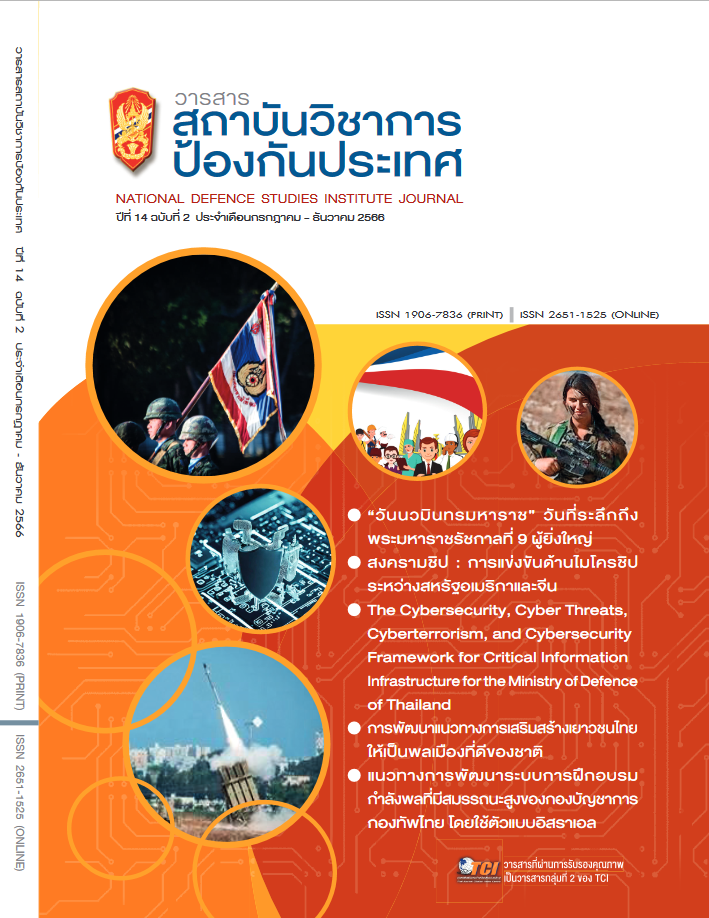The Self-creation in the Military Identity of Chulachomklao Royal Military Academy Cadets
Main Article Content
Abstract
The military is an important profession in maintaining the peace and stability of Thailand from the past to the present. The person who graduated from the military academy will be unique characteristics that are different from the other professions. This research applied a mixed-method approach to 1) study the level of self-creation, 2) compare the self-creation in the military identity of the cadets classified by classes, and 3) suggest a guideline to improve self-creation in the military identity of Chulachomklao Royal Military Academy (CRMA) cadets. By purposive sampling, 17 cadets in command positions were chosen as key informants. Followed by stratified random sampling, 60 cadets from each year were chosen from the 1st to 5th years in the 2022 academic year, resulting in 300 participants. The research instruments included a brainstorming activity worksheet, the test of self-creation scale, with a reliability of .97. The data was analyzed by mean, standard deviation, one-way analysis of variance (One-way ANOVA), and analytic induction.
This research found that: 1) Overall of self-creation in the military identity of CRMA cadets is high. 2) The overall result of self-creation in the military identity of the cadets in different cadet year was statistically significant at level 0.01 (p<.01). 3) The guidelines for developing the self-creation in the military identity of the cadets by creating good military attitudes, the promotion of role model in military behavior/skills, and the provision of effective military literacy through various courses and CRMA activities. The research results will benefit military academies and personnel involved in promoting self-creation in the military identity according to the roles of being a cadet before graduating as a commissioned officer with the desirable characteristics of the Royal Thai Army.
Article Details

This work is licensed under a Creative Commons Attribution-NonCommercial-NoDerivatives 4.0 International License.
The articles, images, tables, graphs, written content, and opinions published in this journal are solely those of the authors and do not necessarily reflect the views or positions of the National Defence Studies Institute or its academic affiliates.
References
กองทัพบก. (2565). คำสั่งกองทัพบก ที่ 1/2566 เรื่อง นโยบายการฝึกอบรมและการศึกษาของกองทัพบก พ.ศ. 2566-2567. 13 ตุลาคม 2565.
ฉัตรทิพย์ สุวรรณชิน, และพนมพร จันทรปัญญา. (2558). การสร้างอัตลักษณ์ของผู้เรียนในระดับอุดมศึกษา. วารสารปัญญาภิวัฒน์, 7(2), 267-280.
ธงชัย สมบูรณ์. (2560, 31 ธันวาคม). โลกหลังยุคใหม่ อนาคตทางการศึกษาและปัญญาของชาติ. มติชนออนไลน์. สืบค้นเมื่อ 9 มิถุนายน 2566, จาก https://www.matichon.co.th/columnists/news_783896
นันทวัน อินทชาติ. (2560). การวิเคราะห์องค์ประกอบของคุณลักษณะที่พึงประสงค์ของผู้นำทางทหารในมุมมองของนักเรียนนายเรืออากาศ โรงเรียนนายเรืออากาศนวมินทกษัตริยาธิราช. วารสารวิชาการศิลปศาสตร์ประยุกต์, 10(2), 36-46.
บุญชม ศรีสะอาด. (2560). การวิจัยเบื้องต้น (พิมพ์ครั้งที่ 10). กรุงเทพฯ: สุวีริยาสาส์น.
ภวิกา ภักษา. (2564). การรู้จักตัวตนบนสถานการณ์แห่งวิกฤต: โควิด-19. วารสารราชภัฏสุราษฎร์ธานี, 8(1), 55-79.
รุ่งอรุณ วัฒยากร. (2561). ปัจจัยที่ส่งผลและแนวทางการส่งเสริมการปรับตัวของนักเรียนนายร้อยใหม่ โรงเรียนนายร้อย พระจุลจอมเกล้า. วารสารวิชาการมนุษยศาสตร์และสังคมศาสตร์ โรงเรียนนายร้อยพระจุลจอมเกล้า, 5(1), 209-242.
_______________. (2563). ความสามารถในการบริหารเวลาของนักเรียนนายร้อย โรงเรียนนายร้อยพระจุลจอมเกล้า. วารสารวิชาการมนุษยศาสตร์และสังคมศาสตร์ โรงเรียนนายร้อยพระจุลจอมเกล้า, 7(1), 51-63.
โรงเรียนนายร้อยพระจุลจอมเกล้า, กรมนักเรียนนายร้อยรักษาพระองค์. (2565). คู่มือนักเรียนนายร้อย พ.ศ. 2565. กรุงเทพฯ: โรงเรียนนายร้อยพระจุลจอมเกล้า.
โรงเรียนนายร้อยพระจุลจอมเกล้า. (2566). รายงานการประเมินตนเองประจำปี 2565. นครนายก: โรงเรียนนายร้อยพระจุลจอมเกล้า. (อัดสำเนา).
วรวุฒิ แสงทอง, และวิรัช วิรัชนิภาวรรณ. (2561). การบริหารจัดการเพื่อเสริมสร้างคุณลักษณะผู้นำของนักเรียนนายร้อย โรงเรียนนายร้อยพระจุลจอมเกล้า. วารสารวิชาการมหาวิทยาลัยอีสเทิร์นเอเชีย ฉบับสังคมศาสตร์และมนุษยศาสตร์, 8(3), 251-263.
ศรีเรือน แก้วกังวาล. (2561). ทฤษฎีจิตวิทยาบุคลิกภาพ. กรุงเทพฯ: หมอชาวบ้าน.
สินาพร วิทยาวนิชชัย, อรพินทร์ ชูชม, และอัจศรา ประเสริฐสิน. (2562). การศึกษาอัตลักษณ์แห่งตน และอัตลักษณ์ ทางวิชาชีพของนักศึกษาพยาบาล. วารสารบัณฑิตศึกษา มหาวิทยาลัยราชภัฏวไลยอลงกรณ์ ในพระบรมราชูปถัมภ์, 13(3), 125-136.
สุวรา คำพระบุรี. (2554). การศึกษาความพึงพอใจของนักเรียนนายร้อยตำรวจที่มีต่อการให้บริการและสวัสดิการของโรงเรียนนายร้อยตำรวจ (วิทยานิพนธ์ปริญญามหาบัณฑิต). กรุงเทพฯ: มหาวิทยาลัยศรีนครินทรวิโรฒ.
อภัสรินทร์ ขณะรัตน์, กิตติกร สันคติประภา, และสุรวุฒิ ปัดไธสง. (2559). กระบวนการสร้างตัวตนของนักเรียนอาชีวศึกษา โดยปฏิบัติการศึกษาผ่านประสบการณ์. วารสารวิจัยและพัฒนาหลักสูตร, 6(1), 61-92.
อารีย์วรรณ สุทธิพงศ์พันธ์, และพฤทธิ์ ศิริบรรณพิทักษ์. (2565). ทักษะทางการเงินของนักเรียนนายร้อย. วารสารมนุษยศาสตร์และสังคมศาสตร์ มหาวิทยาลัยราชภัฏพิบูลสงคราม, 16(2), 628-645.
Allport, G. W. (1961). Pattern and growth in personality. New York: Holt, Rinehart & Winston.
Bloom, B. S. (1972). Taxonomy of Educational Objectives, Handbook 1: Cognitive Domain (17th ed.). New York: McKay.
Cronbach, L. J. (1963). Educational Psychology. New York: Harcourt Brace and World.
Morris, C. G. (1990). Psychology: An Introduction (7th ed.). New York: Prentice Hall.
The United States Army, Headquarters, Department of the Army. (1958). FM 22-100 Military Leadership.


